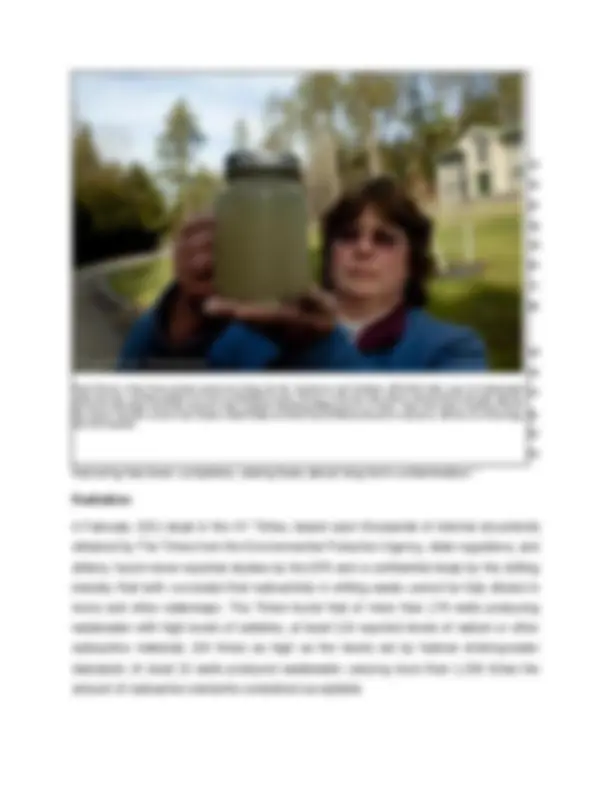








Study with the several resources on Docsity

Earn points by helping other students or get them with a premium plan


Prepare for your exams
Study with the several resources on Docsity

Earn points to download
Earn points by helping other students or get them with a premium plan
Community
Ask the community for help and clear up your study doubts
Discover the best universities in your country according to Docsity users
Free resources
Download our free guides on studying techniques, anxiety management strategies, and thesis advice from Docsity tutors
contamination
Typology: Lecture notes
1 / 10

This page cannot be seen from the preview
Don't miss anything!







In oil industries, drilling starts from fracking the shale to create an opening upon upstream operations. Fracking is the process of pumping the mixture of water to a rock formation so that the gas flows out from its source. Although fracking is one very odd process, the breaking of the rock formation brought damages to the environment and common good of the people living near where the operation occurs.
The issues of pollution in the groundwater are put blame on the fracking operations. Fracking contains potentially toxic chemicals according to the International Journal of Human and Ecological Risk Assessment. As well as potential chemicals the wastewater contains natural contaminants from deep underground including total dissolved solids, organic pollutants and normally occurring radioactive material.
Pennsylvania one example and known on this issues. Almost percentage of 65 wells in the country had high levels of radiation in wastewater samples, and that wastewater discharges into rivers and streams. More than a billion gallons of wastewater was produce by Pennsylvania wells. Fracking – water contaminants maybe chemicals, beneze, radiation and bacterial methane that make the water unsafe to use.
Environmentalist and people live near the area blamed the polluted water coming out from the faucets as the effects of fracking the shale formation. Lots of countries have this situation but science still got no proof to direct the variable as the cause of groundwater contamination. Also there are cases under the environmental laws upon this disaster.
Fracking is the process of drilling down into the earth before a high-pressure water mixture is directed at the rock to release the gas inside. Water, sand and chemicals are injected into the rock at high pressure which allows the gas to flow out to the head of the well. The process can be carried out vertically or, more commonly, by drilling horizontally to the rock layer and can create new pathways to release gas or can be used to extend existing channels. The term fracking refers to how the rock is fractured apart by the high pressure mixture.
According to the International Journal of Human and Ecological Risk Assessment: Wastewater from fracking contains potentially toxic chemicals used in fracking fluid, as well as natural contaminants from deep underground, including total dissolved solids (e.g., salts, barium, strontium), organic pollutants (e.g., benzene, toluene) and normally occurring radioactive material (NORM) such as Radium 226.
An estimated 30% to 70% of the fluid used in fracking will resurface, requiring treatment. Fracking also releases "produced water" from underground that also rises to the surface, and can be anywhere from two to 200 times as much water, depending on the oil/gas/water concentrations in the shale formation.
In 2010, Pro Publica reported that states were largely unprepared for dealing with the sudden surge of fracking wastewater. It pointed to Pennsylvania, which was dumping hundreds of millions of gallons of fracking wastewater into streams across the state, according to state records. Pro Publica reported that "while the state Department of Environmental Protection called for the fluids to be sent through municipal treatment plants, those facilities is largely unable to remove the salts and minerals, also known as Total Dissolved Solids (TDS), from the waste."
In 2011, the New York Times reported that 116 of 179 Marcellus wells in Pennsylvania had high levels of radiation in wastewater samples, and that wastewater discharges into rivers and streams were untested for radiation. The Times concluded that "More than 1.3 billion gallons of wastewater was produced by Pennsylvania wells [from 2008 to
In April 2011, Democratic members of the House Committee on Energy and Commerce released a report detailing the range of chemicals used in fracking. According to the report, the most widely used chemical in fracking fluids, methanol, is a hazardous air pollutant and is on the candidate list for potential regulation under the Safe Drinking Water Act. Isopropyl alcohol, 2-butoxyethanol, and ethylene glycol were the other most widely used chemicals. The study noted that in some cases benzene (a known carcinogen), toluene, xylene, and ethylbenzene are used. Many of the hydraulic fracturing fluids contain chemical components that are listed as “proprietary” or “trade secret.”
Of the 300-odd compounds that private researchers and the Bureau of Land Management suspect are being used in fracking, 65 are listed as hazardous by the federal government. The New York State Department of Environmental Conservation was tasked with going through a public review of its new rules on hydraulic fracturing, and looked into reports that "gas companies use at least 260 types of chemicals, many of them toxic, like benzene." The chemicals tend to remain in the ground once the fracturing has been completed, raising fears about long-term contamination."
A February 2011 study in the NY Times, based upon thousands of internal documents obtained by The Times from the Environmental Protection Agency, state regulators, and drillers, found never-reported studies by the EPA and a confidential study by the drilling industry that both concluded that radioactivity in drilling waste cannot be fully diluted in rivers and other waterways. The Times found that of more than 179 wells producing wastewater with high levels of radiation, at least 116 reported levels of radium or other radioactive materials 100 times as high as the levels set by federal drinking-water standards. At least 15 wells produced wastewater carrying more than 1,000 times the amount of radioactive elements considered acceptable.
Carol French of the Pennsylvania Landowner Group for the Awareness and Solutions (PLGAS) holds a jar of contaminatedwater from the well that supplies her home in Bradford County. French, a mid-size dairy farmer, leased land to the gas industry but found information about the impacts of the hydraulic fracturing drilling process on land, water and roads is lacking. Frenchhas spoken at public events in the eastern United States to inform local residents about her experience with the new technology and local impacts.
A November 2010 study of fracking's effect on radioactive material in the Marcellus Shale by Tracy Bank, a geologist at the State University of New York in Buffalo, found that the process that released the gas also releases uranium trapped in the shale. She said additional study is needed to understand and predict the reaction in the shale to fracking.
Methane in itself is not considered toxic by U.S. regulations, but concentrations of it in enclosed spaces raise the risk of explosions. The 2011 peer-reviewed study, "Methane contamination of drinking water accompanying gas-well drilling and hydraulic fracturing," found "systematic evidence for methane contamination" of drinking water associated with shale gas extraction." Water wells half a mile from drilling operations were contaminated by methane at 17 times the rate of those farther from gas developments.
A 2013 PNAS study analyzed 141 drinking water wells across northeastern Pennsylvania, and detected methane in 82% of drinking water samples, with average concentrations six times higher for homes less than 1 km from natural gas wells.
According to Cornell University engineer Anthony Ingraffea, oil/gas industry studies show that five to seven per cent of all new oil and gas wells leak methane. As wells age, the percentage of methane leaks can increase to 30 or 50 per cent. The worst leaks are "deviated" or horizontal wells commonly used for hydraulic fracturing.
Some of the natural gas harvested by hydraulic fracturing operations may be of biological origin, but created by microorganisms inadvertently injected underground into shale by drillers during fracking.
Ohio State University and West Virginia University scientists tested fluids taken from a well operated by Northeast Natural Energy in West Virginia. They measured the genes, enzymes and chemical isotopes in used fracturing fluid drawn from the well for more than a year.
contamination of drinking water accompanying gas-well drilling and hydraulic fracturing," PNAS, April 14,
Robert B. Jacksona, Avner Vengosha, Thomas H. Darraha, Nathaniel R. Warnera, Adrian Downa, Robert J.
Poredac, Stephen G. Osbornd, Kaiguang Zhaoa, and Jonathan D. Karra, "Increased stray gas abundance in a subset of drinking water wells near Marcellus shale gas extraction," PNAS, June 3, 2013.
December 14, 2015.
Phys.org, August 3, 2015.
December 14, 2015.
Other Illnesses" EcoWatch, March 10, 2015.